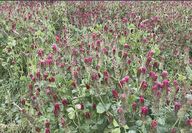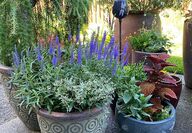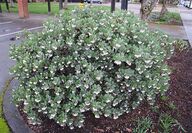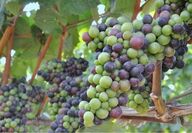Sorted by date Results 176 - 200 of 340

rvest's end as the vegetable garden reaches peak, but now's the time to plan for cover crops to be planted in fall. Cover crops, also called green manure, include grains like winter oats and cereal rye. Legumes, such as commonly used crimson clover, Austrian field pea and common vetch, are nitrogen "fixers." Beneficial bacteria in legume root nodules take nitrogen from the air and supply it to the plant. When the cover crop decomposes, some of the nitrogen becomes available to other plants. If...

Thanks to zealous breeding and new hybridizing techniques, begonias are booming right along with the renaissance of houseplants. Nicole Sanchez, horticulturist for Oregon State University Extension Service, knows first-hand how rewarding begonias can be for both beginners and experts. She became a convert as a teenager when she worked at a garden center. Now, her five plants reside in an east window and thrive with little input. Watering properly – not too much – and light fertilizer are all...

Often not considered, soil pH has as much effect on plant health as disease, insects, drought and drainage. Keeping pH in the right range for certain plants is essential, according to Weston Miller, Oregon State University Extension Service horticulturist. Plants with specific pH requirements include vegetables, blueberries and rhododendrons. Soil pH is a measurement of acidity or alkalinity and measured on a scale from 0 to 14, with 7 being neutral. Lower numbers equal a more acidic or sour...

e distraught by the damage suffered by their plants during the recent heat wave. Questions have come pouring into Oregon State University Extension Service and experts weigh in on what to do now. There's no denying the damage is severe, said Heather Stoven, OSU Extension horticulturist. Some plants died and others were fried by the record-breaking temperatures. Even some that look extremely bad, like rhododendrons and hydrangeas, can bounce back. Burned leaves don't necessarily equal a dead...

e distraught by the damage suffered by their plants during the recent heat wave. Questions have come pouring into Oregon State University Extension Service and experts weigh in on what to do now. There's no denying the damage is severe, said Heather Stoven, OSU Extension horticulturist. Some plants died and others were fried by the record-breaking temperatures. Even some that look extremely bad, like rhododendrons and hydrangeas, can bounce back. Burned leaves don't necessarily equal a dead...

est that arrived in the United States in the 1920s as fishing bait and as hitchhikers on imported plants and soils, have vaulted into gardens and nurseries up and down the Willamette Valley corridor. Unlike beneficial earthworms and nightcrawlers that burrow deep tunnels in the soil, aerating and releasing nutrients as they go, jumping worms stay in the debris on top and eat two to three times the amount of leaf litter as the other worms, according to Sam Chan, Oregon State University Sea Grant...

People and plants need care to make it through heatwaves without wilting. Erica Chernoh, Oregon State University Extension Service horticulturist, offers some ideas to help keep yourself and your garden as comfortable as possible. Keep hydrated. Carry a water bottle – and use it! You need water as much as your plants do. If you plan to work in the garden, do it in the morning before the hottest part of the day. Wear a hat and lather on the sunscreen when outside. Water in the morning to give pla...

Knowing the whys and hows of tomato diseases gives gardeners a leg up for successfully growing the most-treasured of vegetables. Brooke Edmunds, a horticulturist with Oregon State University Extension Service, troubleshoots the following common problems that might afflict your tomatoes as the season goes on. Blossom drop – It's usually caused by dry soil and dry winds, but also may be caused by a sudden cold spell, heavy rain, or too much nitrogen. Usually, not all blossoms will fall off, and a...

Growing melons takes some effort in western Oregon, but with the right methods it can end in sweet success. With a warmer, drier climate, eastern Oregon is well set up for cultivating melons. Western Oregon isn't as hospitable, but you can accomplish a crop by choosing the right variety and following tips from Heidi Noordijk, metro small farms outreach coordinator for Oregon State University Extension Service. "Be discerning when you choose a variety," Noordijk said. "Select ones that will...

In a world of increasing climate change and the invasion of more exotic insects and pests, sustainable gardening is more important than ever. We can all do our part to help by changing our practices – often just by a bit, depending on the methods you've already put in place. And if it all seems too overwhelming, take it one step at a time. You'll help the environment and at the same time save money and join a community of like-minded gardeners who love to share their experiences. To get you star...

It's spring and that means it's time to start slugging it out with one of the gardener's most familiar, frustrating and certainly slimiest pests. You guessed it, slugs are ready to pounce – or, more accurately, slowly slither – their way through the garden leaving wreckage behind. As soil temperatures start to climb, they rise from their winter hiding place underground to munch tender seedlings, emerging perennials and even seeds. "What slugs want is a place that's warm and moist," said Cla...

Dahlias are addictive, at least for Julie Huynh Moore, an Oregon State University Master Gardener, who plans to grow 2,000 by the end of May. That's quite an accomplishment for anyone, but considerably more for Moore, who lost her home and all 1,200 of her dahlias in the Labor Day wildfires. When she was allowed to return after nine days, the ground was empty. Not one of the fully blooming dahlias were left. Surprisingly, after a couple of weeks, sprouts starting showing, but when she dug them...

Considering the 80 million home lawns in the country, there are a lot of people buying lawn mowers. How you choose between rotary, reel and electric models has to do with your situation and preferences, said Alec Kowalewski, Oregon State University Extension turf-grass specialist. All three have their pros and cons. Rotary and electric mowers, which have one blade, cut like weed wackers with the blade spinning in a circle. Reel (push) mowers, on the other hand, are designed with two blades that...

Spring is here and you're raring to get your vegetable garden going. Well, hold on just a minute. Sowing seed or planting seedlings at the wrong time will bring nothing but heartache. One of the biggest mistakes people make is to plant too early," said Weston Miller, a horticulturist with Oregon State University's Extension Service. "They get excited when it's sunny for a few days, put plants in the ground and think they will grow. But the seeds either rot from damping off fungus or germinate...

As the heat ratchets up so does water use, costing homeowners money and doing no favors for the environment. Homeowners can learn to save water and money, however, with help from Oregon WaterWise Gardening, a statewide program of the Oregon State University Extension Service. Its website includes profiles of water-efficient plants. Amy Jo Detweiler, a horti-culturist with OSU Extension, compiled the following tips to help you conserve water and save on summer water bills: * When you’re s...

State University-developed tomato Midnight Roma follows in the steps of 10-year-old Indigo Rose, the first antioxidant-rich purple tomato available on the market. Indigo Rose was bred by Jim Myers, vegetable breeder and professor in the OSU College of Agricultural Sciences. Midnight Roma is the result of crossing Oregon Star, a big, fleshy tomato good for slicing or paste with excellent flavor, and Indigo Rose, a dark purple tomato that contains anthocyanins, the same healthy antioxidants found...

After hatching in spring, baby birds sometimes end up on the ground, but that doesn’t necessarily mean they need help. It depends on how old they are, how long they’ve been on the ground and whether they are injured, said Dana Sanchez, Oregon State University Extension Service wildlife specialist. Identifying the age of a bird is crucial in how you deal with one. The youngest are newly hatched fledglings and should not be without their parents. Older nestlings, on the other hand, are bet...

Ask experienced gardeners what makes their garden grow and they'll come up with the same response: great soil. Good answer, but not the only one. The same crops grown in soil thrive in water, too, as long as there are nutrients and oxygen involved. In fact, vegetables grown hydroponically root and grow faster than traditionally grown plants, said Barry Burnsides, an Oregon State University Extension Service master gardener. This ages-old system uses a mixture of water and nutrients to grow...

Many vegetables grow well in containers located on a patio, porch, balcony or windowsill, so don’t let lack of yard space keep you from gardening this spring and summer. Limited garden space precludes being able to grow some of the larger vegetables, according to Brooke Edmunds, Oregon State University Extension Service horticulturist. For instance, growing corn on a balcony may not be practical. But a wide variety of crops can be planted, including lettuce, herbs, tomatoes, peppers, e...
Asparagus Growing asparagus requires patience – from planting to harvest takes two to three years, but the wait is well worth the reward. Homegrown asparagus is one of the earliest vegetables of spring. Its quality is much better than store-bought spears, and it’s less expensive. Once established, this vegetable easy to grow. And asparagus is beautiful. A member of the lily family, its fern-like foliage turns from green to gold in fall, and can be a backdrop to chrysanthemums or other late-season flowers. Oregon State University E...
Artichoke With deeply lobed silver leaves and a 3-foot stature, the artichoke unfolds as much mystery in the garden as it does on the dinner table. Used to set off any color in a perennial border, as a striking specimen plant or the flagship of a vegetable garden, the artichoke has much to recommend it to the gardener. But the reason most people grow them are the leathery leaves made to dip into butter – or is it mayo? – and the succulent heart at the center. Although most artichokes thrive in the cool, moist climate of coastal Cali...

Once grape vines lose their leaves, the plants fade into the background of the winter landscape. That’s the time to take action and get out the clippers. January through the first of March is the season to prune your vines, said Bernadine Strik, a berry specialist with Oregon State University Extension Service. First, though, you’ve got to know how to do it properly. “Home grape growers don’t prune their vines enough,” said Strik, who is the author of Extension’s Growing Table Grapes publ...
Painted Lady By Kym Pokorny Fragile, beautiful and fascinating, butterflies flutter their way into our gardens and seem to just as quickly wing their way out. It isn’t because they necessarily want to leave, said Heather Stoven, an entomologist with the Oregon State University Extension Service. Rather they don’t find what they need to park themselves permanently. As detailed in Extension’s publication The Wildlife Garden: How to Create a Butterfly Garden, buetterflies require specific room and board to have their needs met. As with all wildl...
Veggies in pots By Kym Pokorny The COVID-19 pandemic has inspired millions of people to grow vegetables, but many don’t have room for traditional gardening. Don’t let lack of yard space keep you from gardening this spring and summer. Many vegetables grow well in containers on a patio, porch, balcony or windowsill. Small spaces make it hard to grow some of the larger vegetables, according to Brooke Edmunds, Oregon State University Extension Service horticulturist. For instance, growing corn on a balcony may not be practical. But a wide var...
Sticks on fire By Kym Pokorny About 10 years ago, succulents began an extraordinary rise in po an extraordinary rise in popularity. They turned up everywhere – on windowsills, in wreaths and centerpieces, arranged in frames, even dyed. Nowadays, succulents are hipper than ever. Everyone seems to have at least one. Marcia Sherry, an Oregon State University Extension Service Master Gardener since 1999, has many more than that – around 50 different varieties at last count. When she was in college, Sherry came face to face with a...